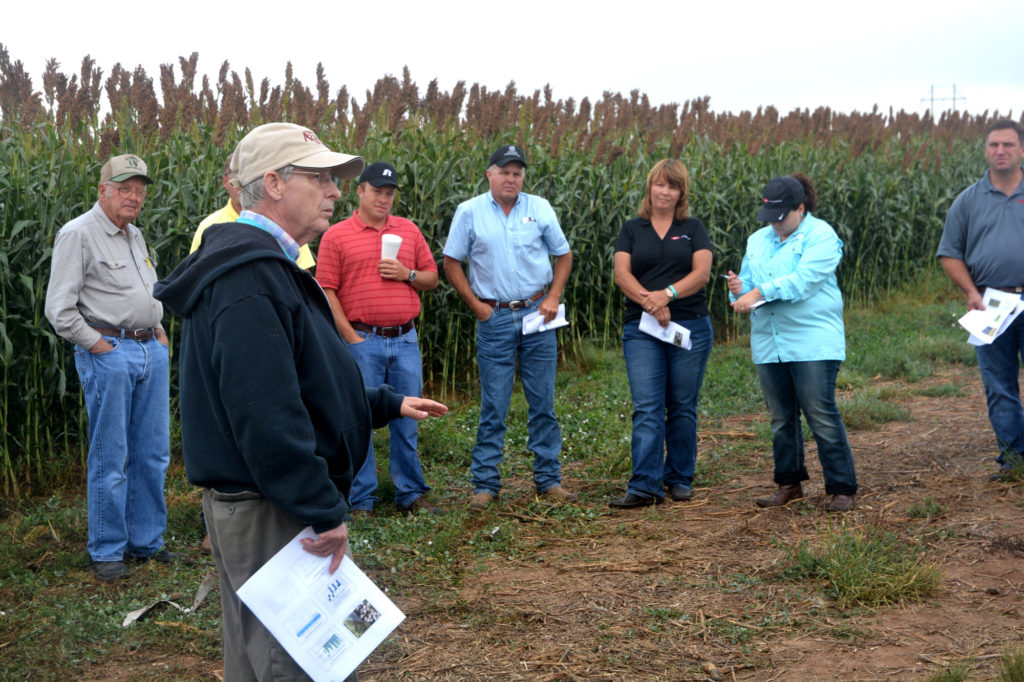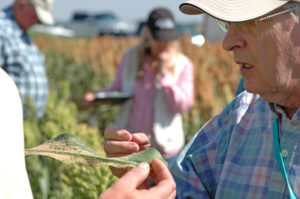Bynum leaves agriculture pest management behind; retires after more than 40 years
Writer: Kay Ledbetter, 806-677-5608, [email protected]
Contacts: Dr. Ed Bynum, 806-677-5600, [email protected]

AMARILLO — With more than 40 years of service to Texas A&M AgriLife under his hat, Dr. Edsel “Ed” Bynum Jr. will no longer be traipsing out to fields across the High Plains and South Plains looking for the latest insects pestering agricultural crops.
Bynum, Texas A&M AgriLife Extension Service entomology specialist in Amarillo, is retiring June 30. A retirement party will be hosted from 5-7 p.m. on June 20 at the Texas A&M AgriLife Research and Extension Center, 6500 Amarillo Blvd. West, Amarillo.

“As I look back at my career, two things occur to me,” he said. “I began in research and by far the biggest changes have been with the technology that has occurred through production agriculture.
“But when I think of my extension work, I think about how rewarding it has been to work closely with producers, crop consultants and the ag industry to address the day-to-day challenges for managing insect pests.”
Bynum spent the past 10 years as the AgriLife Extension entomologist serving the Amarillo area. Prior to that, he served as the AgriLife Extension integrated pest management agent for Nolan, Mitchell, Scurry and Jones counties from 2005-2008.
Previously, he worked for Texas A&M AgriLife Research with a variety of titles, from technician to research associate to assistant research scientist, at the Lubbock center working primarily with grain crops and the Dallas center working primarily with cotton breeding lines for resistance to flea hoppers.
Bynum said tackling pest management issues has changed tremendously with the growth in computer technology.
“When I first started in 1976, we didn’t have computers to do data analysis very quickly,” he said. “Our first Radio Shack computer had a 5.25-inch floppy disk that was an operating system, and there was no software to help conduct the research. Now everything is so quick, and it makes a difference in our ability to do data analysis.
“We have apps on our cell phones that allow a producer to take a picture in the field and send it for immediate identification as well as management advice,” Bynum said. “We can pull together best management practices and email or text them to our clientele in a matter of minutes instead of it taking days to spread the word.”

During his career, Bynum worked extensively with pests such as the sunflower moth, Russian wheat aphid, greenbug, southwestern corn borer, two-spotted spider mite, Banks grass mite, corn earworm, fall armyworm, cotton flea hopper, and most recently, the sugarcane aphid.
“In the field of entomology, we always have outbreaks of insects,” he said. “My first experience was probably with Russian wheat aphid in 1986. Besides the outbreaks, we have to deal with a lot of pests developing resistance to insecticides.”
Bynum said much of his career has been centered on corn and sorghum insect pests, and evaluating insecticide resistance. This included spider mites on corn during the ‘70s and ‘80s and later greenbug resistance to Lorsban insecticide.
“This was probably the most challenging part of my career because the pests were developing resistance to different modes of actions, and we were constantly trying to evaluate new modes of actions for ways to control them.”
This included conducting laboratory assays to determine the level of resistance developed, and then working with the chemical industry to evaluate new products. Also, he said they evaluated host-plant resistance and biological control to help overcome damage from insects.
Another rewarding part of the job was the development of economic thresholds that producers could use to make control decisions.
“Now, we’ve come full circle. We have insecticide resistance that continues to be an issue for the industry along with resistance to Bt traits,” Bynum said. “So instead of relying on this technology, we have to go back to relying on more integrated pest management.
“Insects will always find a way to overcome methods of control, so producers need to have more than one tool in the toolbox that they rely on. Here I am ending my career, and we are again addressing some of the same problems as when I first started.”
He said new technologies are already on the horizon to help battle insects such as corn earworm/cotton bollworm that have built up resistance to Bt traits.
“This area has grown tremendously in cotton production, and that may bring increased pest issues,” Bynum said. “So, integrated pest management for cotton is very important now, as it is still fairly new to our producers and current thresholds may be different. The insects may be the same as in the South Plains, but their management varies with growing conditions.”
Bynum said he will continue to work with Dr. Jourdan Bell, AgriLife Extension agronomist, to complete a project on sugarcane aphids, but his primary focus in the future will be spending more time on his artwork and with his family.
Bynum earned his bachelor’s degree in animal production, a master’s degree in entomology and a doctorate in agronomy from Texas Tech University.
He is a longtime member of the Entomological Society of America, as well as the Society of Southwestern Entomologists, where he served as a past president.
His recognitions include: Superior Service team award for sugarcane aphids; the Texas County Agricultural Agents Association distinguished achievement award; Meritorious Award for Technical Staff Support from Texas A&M’s entomology department; Research Support – Off Campus Award from Texas A&M; and an award for Outstanding Contributions to the Agricultural Chemicals Industry of West Texas by the West Texas Agricultural Chemicals Institute.


